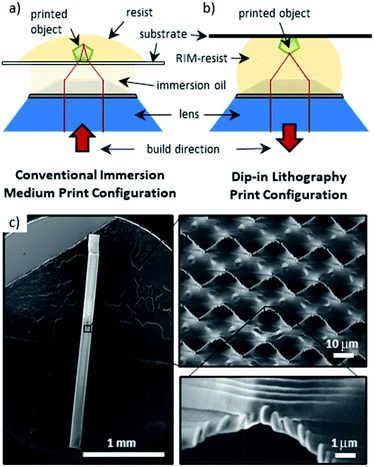Resolution of conventional laser-based advanced manufacturing (AM) techniques are limited by the wavelength of the laser and diffraction. Diffraction limit sets the smallest features size and thus poses a major obstacle for using these laser-based methods to fabricate nanoscale features. To overcome this challenge and fabricate in the nanoscale, two-photon lithography was developed to print microstructures beyond the diffraction limit.
LLNL has been at the forefront of this new technology, developing a TPL system, FemtoProWrite, that can deliver high-throughput 3D printing at the nanoscale. Current TPL systems such as FemtoProWrite can be used to print polymers with very fine nanoscale features, but not for ceramics with comparable feature sizes.
In order to produce 3D printed ceramics with extremely fine details using TPL, a dip-in approach is needed where immersion oil, required for a conventional TPL system, is no longer necessary. In the dip-in TPL configuration, the laser passes through a high numerical aperture (NA) objective lens directly into the optically transparent resist in which the printed object is then formed. For this dip-in approach to work, however, the photoresist must meet the requirements of the high NA objective lens, e.g. a refractive index that is similar to immersion oil (1.52). LLNL researchers have been able to produce such RI matching resins, allowing the production of ceramic components with ultra-fine submicron features.
LLNL’s approach to producing refractive index matching (RIM) resin is to use a commercially available material known as polyhedral oligomeric silsesquioxane (POSS) precursors. To tune the refractive index, POSS can be functionalized with additives such as phenylthiol, until the refracted index match is achieved. For example, for a 1.4 NA oil objective lens, a RIM resin with a refractive index that is close to immersion oil (1.52) is required.
Once a printed ‘green’ object is created in the RI-matching resin using TPL, it is removed and sintered at high temperatures to transform into a ceramic that has finer features than their printed counterparts. LLNL researchers have been able to successfully print RIM preceramic resin composed of phenolthiol-POSS to produce silicon oxycarbide (SiOC) ceramic composite objects.
Mettry, Magi, Worthington, Matthew A., Au, Brian, Forien, Jean-Baptiste, Chandrasekaran, Swetha, Heth, Nicholas A., Schwartz, Johanna J., Liang, Siwei, Smith, William, Biener, Juergen, Saha, Sourabh K., & Oakdale, James S. Refractive index matched polymeric and preceramic resins for height-scalable two-photon lithography. United Kingdom. (https://doi.org/10.1039/D1RA01733K)
- Ceramics materials generally have excellent properties such as being chemically inert and resistant to wear while also can withstand high temperatures and other harsh conditions. Tuning the RIM resin would allow for the production of 3D-printed ceramics with complex and extremely fine structures (≤ 100 microns).
- The RIM resin could be printed with any VAT polymerization system, but the RI must be tuned to be compatible with the high NA objective lens of the printing system.
- Complex design for ceramic blades supporting laser reflective mirrors
- Structural support for beam steering devices
- Complex ceramics for biomedical implants/devices at the nanoscale
Current stage of technology development: TRL 4 (Component and/or system validation in laboratory environment)
US Patent Application Publication No. 2022/0193992 REFRACTIVE INDEX MATCHING BASE RESIN FOR EXTREMELY FINE THREE-DIMENSIONAL CERAMIC STRUCTURES published 06/23/2022


